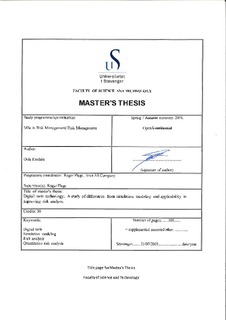| dc.description.abstract | Digitalization, automation, machine learning, smart homes, AI (Artificial Intelligence), VR (Virtual Reality), smart cities and so many other terms are becoming part of almost every day’s activity and can be seen integrated in all industries, driving the development of societies.
One of the latest terms which has been added to this field is “Digital Twin” which is acquiring widespread favor much more recently as digital infrastructure becomes ever more embedded in all industries, major cities and communities.
A digital twin is a mirror for a physical product, project, process or similar. It can be used to run simulations, which leading the digital twin to be considered the new generation of simulation modeling.
In this context, it is crucial to have a closer insight on this technology. It is also important to find out from a risk analysis perspective, the main differences between digital twin as a new concept and simulation modeling which has been used for risk analysis for decades. Digital twin excels simulation with many new features which would help a lot enhancing risk analysis through the lifecycle of a project, such as managing operational risk in the operation phase or supporting decision-making by providing experience data for future analysis. A digital twin could also have an essential role in the design phase by helping with alternative comparisons. in the construction phase, it would provide a great support by avoiding adverse consequences in addition to save both time and cost.
With the rapid development in technology, it is necessary to get the advantage of those new technologies to enhance risk management which achieved, in recent years, significant success by showing an important role among all different domains and industries, as well as by embracing new technologies.
The digital twin is still in its infancy stage; it requires more research to be commenced in order to enhance its use in the areas of risk management in general and risk analysis in particular. | nb_NO |
